The Ghost in the Garage: The dead numbers-matching engine

Today we’re going to talk about the numbers-matching engine. No, not the one that’s already sitting in a valuable restored or survivor car. I’m talking about the one that was long-ago removed from the car and has been kicking around the property ever since like a houseguest who doesn’t know when to leave. Or like a ghost from The Sixth Sense—someone who doesn’t realize that he’s dead.
Back in the fall, I wrote about “the mitzvah 2002tii,” the 1972 BMW I helped a local woman sell on Bring a Trailer after her husband had passed. The car was very pretty and nearly rust-free but had a number of issues that prevented it from coming anywhere close to the six-figure sales prices that best-of-the-best tiis have attained on BaT. At the top of this list: an engine compartment that showed clear signs of metal rework and an undercarriage that, despite having no rust holes, very much wore the car’s 203,000 New England miles on its sleeve.
In addition to those things, the car’s engine had been replaced in 1985. The original (and seized) numbers-matching engine was sitting in the seller’s garage. In the BaT auction, I stated that the numbers-matching engine was included with the sale and that I could assist with the logistics of shipping it (e.g., procure a pallet and strap it to it), but the cost of shipping would need to be borne by the buyer.
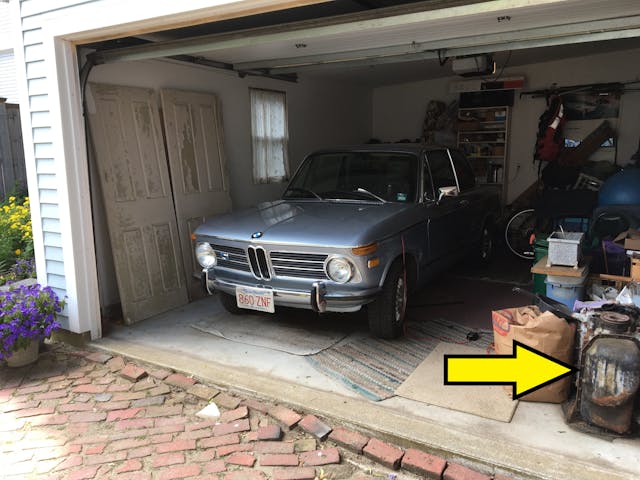
During the auction, I was contacted by a local Porsche guy in Vermont. When he called, his very first question was about the original engine—whether I knew if it failed catastrophically or had seized from sitting and what my experience rebuilding seized BMW M10 engines was. I kind of bit his head off, launching into a somewhat strident lecture about how if that’s the first thing he’s asking about the car, he’s clearly the wrong buyer, and that there was little reason for us to waste each other’s time. To his credit, he then calmly lectured me about how, with an appreciating car like a 2002tii, what may not be important today will likely be important in the future. While I nodded at his perspective, I still felt that elevating the tii’s 38-year-sitting engine above the actually-running car was the seized tail wagging the very-much-still-alive dog.
When the car sold on BaT, the buyer was a fellow in Los Angeles who was not long on detailed communication. It took a couple of emails before I got what I considered a clear unequivocal statement that he did not want the original numbers-matching engine. A few friends of mine were horrified at this. One of them—a pro who wrenches at a shop in San Francisco—commented with a great deal of passion, “The era has passed where one can knowingly let a numbers-matching engine slip away. There are others that are going through hoops to reunite their tiis with their numbers-matching engines. One good friend just drove his halfway across the country to have its original engine reinstated and will happily drive it back in a couple of weeks. We who are true enthusiasts do not understand why a person of means would not at least obtain, for only the cost of shipping, this car’s original numbers-matching engine to keep with it and pass on to the next owner. A significant part of the value in this tii is the knowledge that the original engine is still with the car. Even if in need of rebuilding and not currently installed, there is value left on the table if you don’t do the reasonable thing and keep the engine with the car.”
Personally, I don’t regard this as a moral issue. I asked the buyer if he wanted the engine. He said no. All it meant to me was that I felt that, as my last act helping the seller, it was my responsibility to get the seized lump out of her garage. It was her husband’s car. He was gone. The car was gone. There was no reason for this rusty greasy ghost to continue haunting her garage, but it’s understandable why it was: Engines are heavy. It’s work to move them. I offered it for free on a Facebook page for 2002 owners in the Northeast. There were no takers.
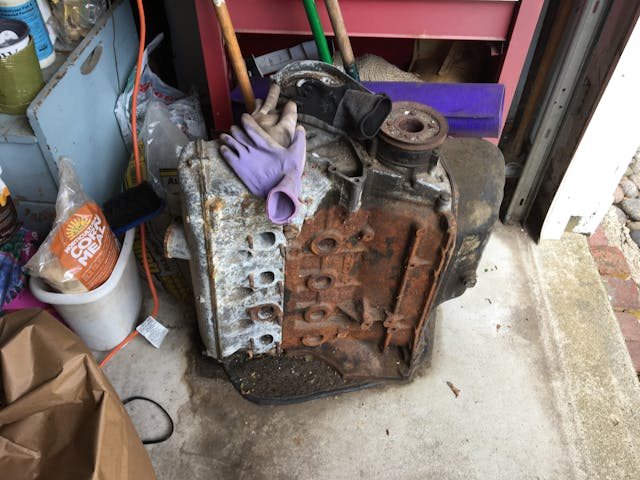
But really, the reason that getting rid of her late husband’s late engine hasn’t risen to the top of my to-do list is that I have the same issue myself: The original engine to my 1973 BMW 3.0CSi has been sitting in the garage at what was my mother’s house in Brighton, Massachusetts, since 1989, and the time has come for me to deal with it.
As I wrote last week, I’ve owned my E9 3.0CSi coupe since 1986. When I bought the car, it had been cracked in the front and needed a nose and fenders and had dents in nearly every body panel, but it was inexpensive and remarkably rust-free. In addition, the fact that it was a CSi carried a certain cache. While the U.S. market received the carbureted 180-horsepower 3.0CS, in Europe you could buy the electronically-injected 3.0CSi which was rated for 200 hp. Some CSis reached our shores through what was then called the “grey market,” but for reasons unknown, mine had never been federalized—its speedometer is still calibrated in kilometers per hour, and thankfully it’s still missing the silly little corner marker lights that were slapped on Federal-spec 3.0CS coupes.

A previous owner had already replaced my car’s original Bosch D-Jetronic injection with a pair of Weber carbs. As it happened, this was the first of many departures from originality, a trend that only accelerated during my stewardship. As I detailed last week, when I had the outer body restoration done on the car in 1988, I not only color-changed it, I selected a color outside BMW’s color palette (Signal Red, used on a number of 1980s Mercedes models). Then I found another E9 that had a tan leather interior, re-dyed it a lighter shade of beige, and swapped interiors.
Then I happened into an engine from a 1984 533i. To be clear, this is merely a newer version of the same straight-six engine that was originally in the car (BMW used this M30 engine from 1968 through 1995), so it’s not like I was LS-swapping the car or anything. The original numbers-matching engine made the 40-foot trip from the side of the curb on the street in front of my mother’s house, where the swap was performed in back of my mother’s garage. Although my wife and I moved out of the house in 1992 and I cleaned most of my stash of parts out in 2016, the engine is still there. And like the mitzvah tii’s engine, why wouldn’t it be? These things don’t evaporate. And unlike body panels, they rust very very slowly.
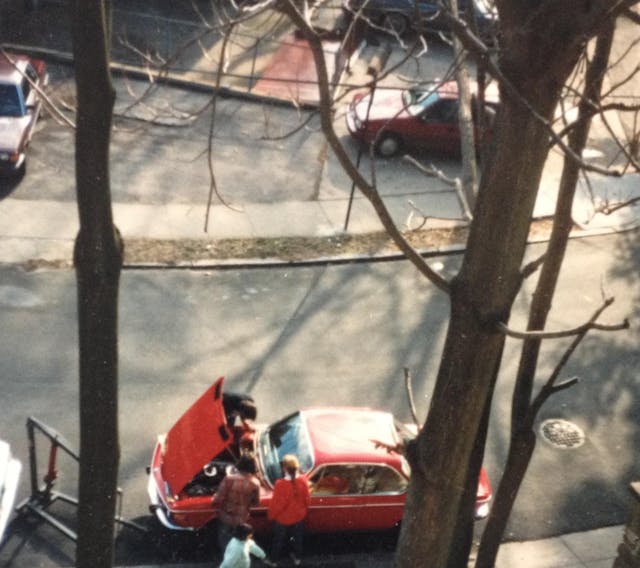
These days, if a removed engine is valuable, either because the engine itself is rare or because its numbers-matching nature makes it so, people talk about “pickling” it. This means filling the cylinders with something like Marvel Mystery Oil, sealing up any port where dirt or humidity can get in, and, if possible, crating the thing, which not only protects it but also gives it the appropriate Raiders of the Lost Ark valuable artifact vibe. In addition, if you’re actively caring for the pickled engine, you rotate it regularly. Like a car undergoing a rotisserie restoration. Or compost.
I, of course, did no “pickling” or other vegetable-inspired preservation with the E9’s original engine. I treated it more like lutefisk. Worse, after shoving the thing into the back of the garage, I stole its valve cover—it turned out that I needed it to backdate something in the replacement engine. I would’ve sworn that I’d put the 533i engine’s valve cover on the original engine to keep the dirt out, but on recent examination, it wasn’t there. So in addition to sitting for 34 years “unpickled,” the valve train was yawning open to contamination. OK, so not lutefisk—more like roadkill.

Despite my neglect, the E9’s original engine survived to the present because it cost me zero in time, space, effort, and money to let it sit where it came to rest 34 years ago. But there’s a new variable at play. When my mother passed in 2019, my sister and I inherited the house. We are embarking on some long-needed improvements to the property, including dealing with the 40-year accumulation of stuff. This includes cleaning the two-car garage I wrenched in from 1984 through 1992, and with that comes confronting the fate of the engine. The M30 straight six probably weighs in at about 350 pounds, so it’s not something you deal with, to make the obvious pun, lightly—you decide where it goes, put it there, and don’t move it again.
But if you’re never going to move it again, aren’t you admitting that you’re never going to use it? And therein lies the rub.
For decades it seemed that the whole numbers-matching engine thing didn’t even apply to my vintage BMW world; it seemed to be a muscle-car-specific thing, crucial to allowing classics like ’63 split-window Corvettes attain their maximum value. In contrast, sales of BMW E9 coupes on Bring a Trailer show that their value doesn’t appear to be hurt by swapping in an entire drivetrain—Motronic-injected 208-hp M30 engine, ECU, wiring harness, sensors, and five-speed—from an early 1990s 535i sedan and getting the benefit of more power, better fuel economy, and improved drivability, provided that the swap is part of a well-executed whole. (I did the light version of that, installing L-Jetronic injection, which is less invasive.)
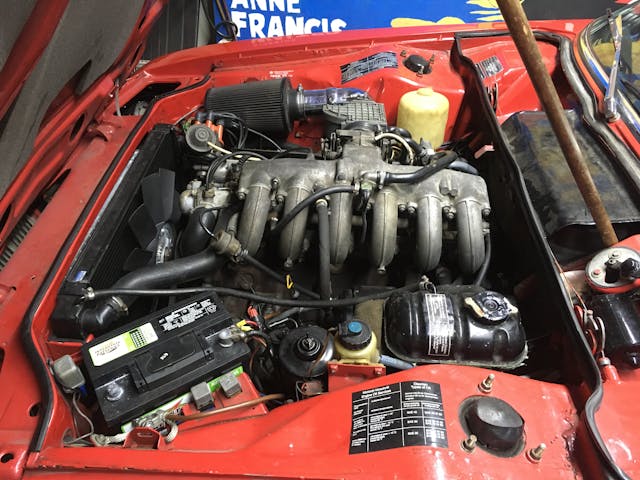
I often think about selling points like the numbers-matching engine from an “all things being equal” standpoint. That is, if you had two cars for sale, identical in every way except that one has the original numbers-matching engine and the other doesn’t, isn’t the former worth more than the latter? Sure, probably, but the point is that you almost never have that situation. Cars are more complicated than that, “worth” is what something sells for, and that can be a function of who’s bidding that particular day. All this crowing about numbers-matching engines strikes me like people who watch gymnastics and shriek from their armchair that, after the gymnast has flown through the air and done impossible twists and turns, they didn’t “stick the landing.” That is, yes, it may lower the score, but the performance may still have been remarkable, and if it’s the only thing someone points out, the criticism may be more a reflection on them than on the performance.
But the Porsche guy in Vermont had a point: With increasing values come new parameters. I may not regard the original numbers-matching engine with any sense of awe, wonder, and reverence, but someone else up the road might.
And yet, when my car has already been color-changed inside and out, when the details would be nitpicked to death because I’m the one who did the work, and I’m, well, The Hack Mechanic and not The Anal-Retentive Mechanic—and, more to the point, when I adore the car and plan to keep it until I die anyway—is there really a universe in which the original numbers-matching engine stands a realistic chance of being reinstalled?
Even looking beyond what happens when I shuffle off my mortal ignition coil, is any potential owner who wants a bone-stock E9 coupe likely to buy this car and set about returning it to originality? Seriously, is someone really going to sand off the gorgeous Signal Red paint and respray the car in the original Polaris (silver), pull the beige leather interior out and hunt down one in the original Navy velour, remove the retrofitted air conditioning, backdate the desirable five-speed gearbox with an original four-speed, yank the updated M30 engine and L-Jetronic injection and replace it with the numbers-matching engine fed by an obsolete and finicky D-Jetronic injection system whose main claim to fame was that it was shielded so badly that it was known to malfunction when nearby truckers with high-wattage CBs did the “breaker breaker” thing?
I don’t think so.
So, shouldn’t I just get rid of the tired, old, numbers-matching mill? Say a prayer for it, thank it for its service, and drop it off at the scrap metal dealer?
Yes.
And yet … would you?
The mechanics of moving the engine aren’t that bad. At first I thought I’d need to disassemble my engine hoist, load it in the truck, and bring it back to the scene of the crime (it’s actually the same hoist I used to pull the engine in 1989), but I can rent a U-Haul trailer and drag the engine onto it with my Warn PullzAll (120V portable electric winch). The bigger problem is that I really have no room for it here at the house in Newton. My garage here is full to bursting. Even the junk area under my back porch is packed with the engine hoist, transmission jack, half a dozen transmissions, the lawnmower, snowblower, power washer, and generator, and a spare engine for a 2002tii (long story). If the engine came here, it would have to sit outside at the end of the driveway, past the off-the-road-for-the-winter Winnebago Rialta, which is where parts go to die. Why do that? Why not just cut the cord now?
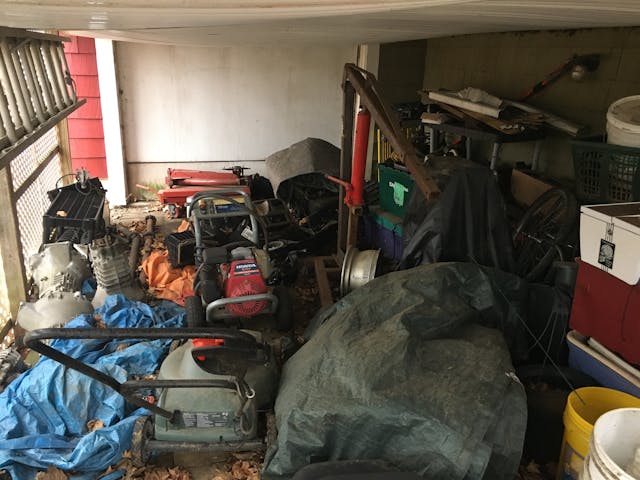
I did a thought experiment regarding dismantling it, but engines are like miniature parts cars—take them apart and their volume explodes. Plus, the irony is that, from a utility standpoint, the part that’s the most useful is the head (M30 engines can easily crack their long straight aluminum head if they’re overheated, and I own two other M30-powered cars). Of course, the part I could care less about—the block—is the thing that’s actually stamped with the VIN-matching number. So, what, I should take it apart and save everything except the block? That doesn’t make any sense either.
Then two things occurred to me. First, I don’t in fact know that it’s the original numbers-matching engine. It makes sense that it is, but I don’t think I ever checked. Second, it’s probably seized from its 34-year-long sit. I realized that if it fails either of those tests, I’d have zero qualms about dragging its long-dormant butt directly to the Newton recycling depot.
So, armed with a roll of paper towels, a can of brake cleaner, a 36mm socket, and a breaker bar, I drove over to the garage in Brighton to examine the engine. I wasn’t surprised when it passed the numbers-matching test—it bore the same 2264290 VIN as the car.

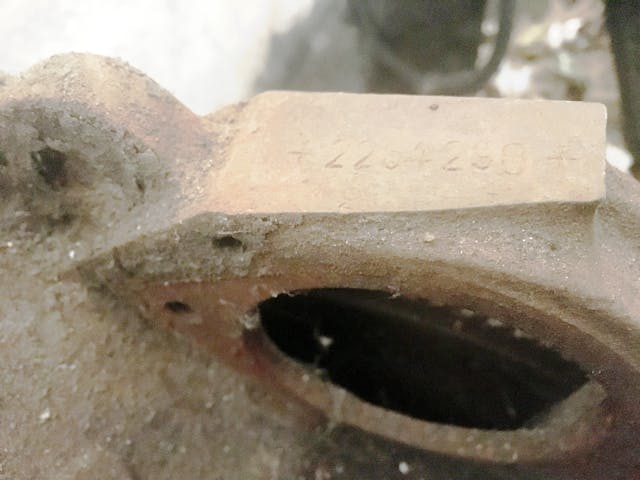
But with the engine sitting for decades unpickled, unsealed, no oil in the cylinders, no annual rotations, and with the valve train uncovered, surely the engine must be seized, right? To my stunned surprise, when I put the socket on the crankshaft nut and leaned on the breaker bar, the engine said, “No, I’m not seized,” then did its best Leslie Neilson impression and said, “And don’t call me Shirley.”
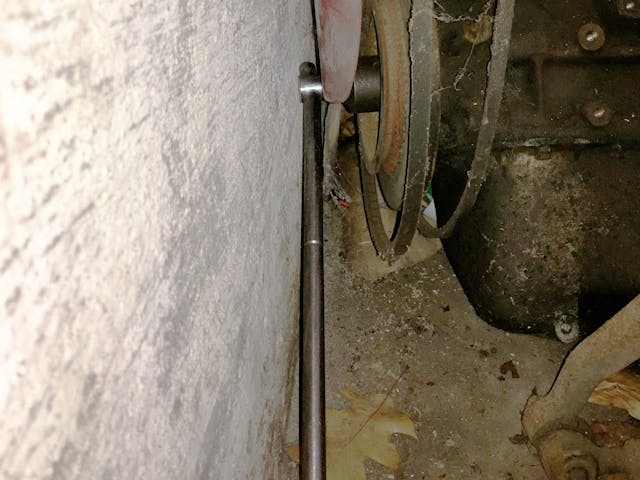
My reaction was sharp: “Damn it!” I said out loud to no one but myself.
So, now I feel honor-bound to keep the damned thing.
Sigh.
What to do with this numbers-matching albatross all comes down to answering this question: To what extent should I feel beholden to a hypothetical decision a hypothetical future owner of the car may want to have the option of making (if you’re counting, that’s four conditionals), when that makes me responsible for keeping a 350-pound block of metal around (and not just “around”—sheltered) until I die?
Maybe a removed numbers-matching engine is a ghost, and not just one that thinks it’s still alive, but one that thinks it has a shot, even a narrow one, at re-inhabiting its original body. But maybe it’s more than that. Maybe, like Bruce Willis’ character in The Sixth Sense, it thinks there’s something it still needs to do in this world. Who am I to tell it otherwise?
***
Rob’s latest book, The Best Of The Hack Mechanic™: 35 years of hacks, kluges, and assorted automotive mayhem is available on Amazon here. His other seven books are available here on Amazon, or you can order personally-inscribed copies from Rob’s website, www.robsiegel.com.
Check out the Hagerty Media homepage so you don’t miss a single story, or better yet, bookmark it. To get our best stories delivered right to your inbox, subscribe to our newsletters.


My opinion is that if you have the room to store it keep it because you just never know…I’ve got an extra engine for most of my vehicles, I always put them on a rollable engine stand, add some Marvel Mystery Oil to the cylinders and cover them with a drop cloth, I usually turn them over a couple times a year. I’ll likely never need any of them but I’m a huge believer in “Murphy’s Law”
Great first image… Just “negatived” or also solarized?
Good article too, as always.
This is funny enough to be Purim toyreh, Rob! But also quite serious, in a similar vein. Keep it! I see free space under your porch, enough to stand a block in (top left). Move your other stuff around enough to get it out of the weather, and cover it up at least!
Enjoyable read, and sorta an enviable problem, as many folks would give a lot to have a rebuildable numbers-matching engine stashed away somewhere – or even to get put into their car. I’m not much into that sort of thing, but I know that a LOT of people are (and reasonably so). I’m also not a BMW guy, so I’ve no idea whether your hypothesis about the odds of anyone ever doing all those things to restore your car makes sense. However, it doesn’t appear to me that retaining it will cost you anything but a bit of sweat and time. I’m with AG1962 – I think with a bit of judicious rearranging, there’s plenty of room for it under the porch!
Just leave it for your heirs – you won’t feel a thing!
I think different things on this:
-in general people way overstate the “numbers matching” thing as being important. Many muscle cars (and for sure prior) cars you have date-coding or less to know if it is correct or not. Important for Shelby Mustang value sure, 6-cylinder Mavericks not so much. The Japanese hero cars of the 90s is a spot we will see this play out as many, many were modded and driven hard. Not that different than trying to find an uncut fender early Bronco. Then again, people cut the fenders for reasons…
-For Rob’s situation though the cars are on an aggressive value climb with no reason to think they will drastically devalue in the next 50 years. It does match, it does turn over. In my head, there is a case for rebuilding this engine and putting it back in the car and/or one of your other keepers. Then it is getting used/maintained correctly. Swapping the engine(s) for the eventual sell day is a theory (or just sell two cars as a set –I’m chuckling at this, but these are up there in value to the average car person).
Just think if the owners would have saved the original Hemi engines they blew up in the first month of ownership.
I feel your pain. What to do with all the “good parts” that get left over after a rebuild? I need two or three bits to restore an old carburetor, I buy an old one with those parts and cannibalize it, complete the rebuild and now I own a 90% complete extra carburetor. That’s already a problem, and then you have your problem, which is worse. Keeping things so others can use them seems like the moral high ground, but how much of it is a delusion? Does anyone really want them? Ask the guy who wrote you that letter explaining exactly why you should keep the engine, how much he’s willing to pay for the whole package you have. Maybe there’s your answer.
Somebody out there might want the engine so they can grind off the vin and restamp it to put it in a different “number matching” car. So you could aiding and abetting a fraud. That seems to be big issue with Corvettes so if the value of the BMW keeps climbing …
Be aware of the font you use in restamping engine numbers, or Adam Levine may sue you!
Stopped reading at “…had a certain cache.” Then you didn’t say what was hidden in it.
Clean it up, paint it to look pretty, build a metal framework to plunk it on And a see thru table top. Then round up 3 or 4 buddies, haul it in the the house to replace your existing kitchen table.